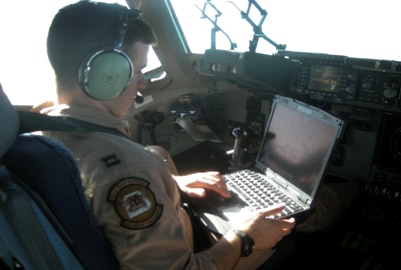
Faced with dearth of replacement part suppliers, Air Force aims to make itself more self-sufficient
With new Rapid Sustainment Office, Air Force looks to cut costs it pays to vendors for boutique parts that it could manufacture on its own.
Best listening experience is on Chrome, Firefox or Safari. Subscribe to Federal Drive’s daily audio interviews on Apple Podcasts or PodcastOne.
The Air Force’s aircraft fleet is getting on in years. One problem with that is that replacement parts are becoming more expensive and more difficult to find, since many of the original manufacturers don’t even exist anymore. But the service is launching a two-year pilot project that may help solve the problem.
As a general matter, the vast majority of the dollars the military spends on large weapons systems has nothing to do with their upfront procurement costs: 70 percent of a program’s lifecycle expenses are connected to long-term sustainment, including spare parts and maintenance-related labor.
But in the Air Force’s case, those costs are growing even larger as its aircraft fleets get older. Take, for instance, the B-52: the last new airframe of that type rolled off the assembly line in the early 1960s. And companies that are willing or capable of making replacement parts are becoming more and more scarce.
“Just in the first quarter of this year, we had 10,000 requests for parts where there wasn’t even a single bidder,” Air Force Secretary Heather Wilson said at an event hosted by the Washington Post last week. “Sometimes that’s because the company’s no longer in business — and there’s no business case for building one part.”
But there’s a vital mission case for building them. As an example, she held up a rudder trim wheel for the 60-year-old KC-135 refueling tanker, 3D-printed by airmen.
“If you don’t have it, you can’t fly, and the company that makes them is no longer in business,” she said. “It cost us about $55, including all of the engineering and everything else. If I had to go out and have [the acquisition community] set up the traditional way to do it, it would be over $700.”
Air Force to stand up Rapid Sustainment Office
The Air Force wants to find out just how regularly it can repeat success stories like that, so last week, it announced the creation of what it calls the Rapid Sustainment Office. The service says it will focus on topics like predictive maintenance and agile manufacturing.
That includes 3D printing, but also cold spray repair technologies, robotics and automation, corrosion detection and repair, nondestructive inspection, and advanced composite repair technologies. The office will start out on a two-year trial basis, but the Air Force will transition it into a permanent organization if it proves successful.
But even though the Air Force is slowly increasing its capability to make its own spare parts, the process is not always as quick or easy as it could be.
That’s because for at least some systems, the government doesn’t own the technical data rights that would tell it exactly how to manufacture parts for the systems it owns, meaning airmen have to reverse-engineer them from scratch.
“We need better laws with respect to intellectual property, because it’s a lot like the ink in an inkjet printer,” said Lt. Gen. Lee Levy, the commander of the Air Force Sustainment Center. “You can get an inkjet printer for not a whole lot of money, but you’re going to have to buy the ink year over year over year. Our procurement strategies haven’t adapted to that. And when we say intellectual property, some people believe that it’s an all or nothing proposition. We don’t want all of the intellectual property to sell it on the open market. What we really want is enough of the intellectual property that we can take care of what the nation has asked us to take care of.”
Latest Defense News
Levy said that’s especially critical when there is no commercial market to provide replacement parts for a particular weapons platform.
“Quite frankly, a lot of companies lose interest in taking care of some of these weapons systems over time,” he told a recent hearing of the House Armed Services Committee. “We collectively worry about companies who don’t want to take care of those platforms: B-52, KC-135, B-1, we could go on and on. But having that intellectual property gives us the ability to do these kinds of things without having to reverse engineer it.”
Levy acknowledged that up until this point, the Air Force has been slower than it could have been to adopt advanced technologies like additive manufacturing. That level of caution is partly because of the military’s concerns over cybersecurity, and the need to make sure the parts it prints are genuinely airworthy.
“Because ultimately, I don’t want to print this at one of my air logistics complexes. I want to send these ones and zeros downrange to Guam, where I’ve got continuous bomber presence, and I want my folks to be able to print it out right there,” he said. “And so when we develop our technical data packages, we need to do it in a way that we can ensure a cyber pedigree. If I send you those ones and zeroes, you and I both need know that the ones and zeros I sent you were the ones you got, and when you print this out, it’s exactly what you expected it to be. This is not an area where we need to be arbitrary or capricious.”
Air Force doesn’t want to pay premiums for parts
In a statement, Wilson said the Air Force is standing up the new Rapid Sustainment Office because it doesn’t want to pay premiums for parts that it could otherwise manufacture on its own.
But even if money were no object, officials think they’re going to have to become more and more reliant on their own organic industrial base to make replacement parts.
The B-52, after all, is expected to stay in the air for several more decades. And Levy said the supply chain for older platforms like that one is getting “extraordinarily brittle.”
“We’ve tended to believe that the Defense industrial base is sort of this arsenal of democracy, and that’s simply not the case anymore, particularly for sustainment,” he said. “A large number of the vendors that we buy from are single-source vendors, and in some cases we have no vendors. These are small companies with 10, 15, 20 employees, and when there’s irregular or inadequate funding, it radiates uncertainty to those small businesses, and they make decisions. When they do, there’s no 1-800 number I can call for B-52 parts. When we can’t get someone to build or make the part for us, we sometimes end up doing it ourselves, and that sometimes takes longer.”
Read more of the DoD Reporter’s Notebook.
Copyright © 2025 Federal News Network. All rights reserved. This website is not intended for users located within the European Economic Area.
Jared Serbu is deputy editor of Federal News Network and reports on the Defense Department’s contracting, legislative, workforce and IT issues.
Follow @jserbuWFED





